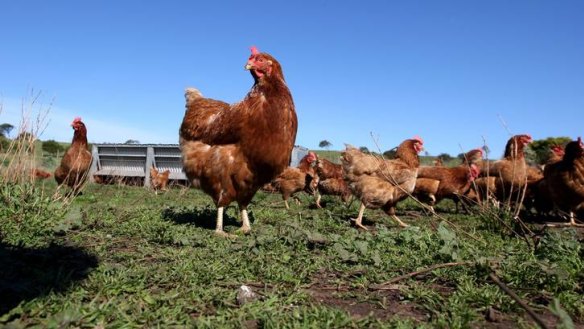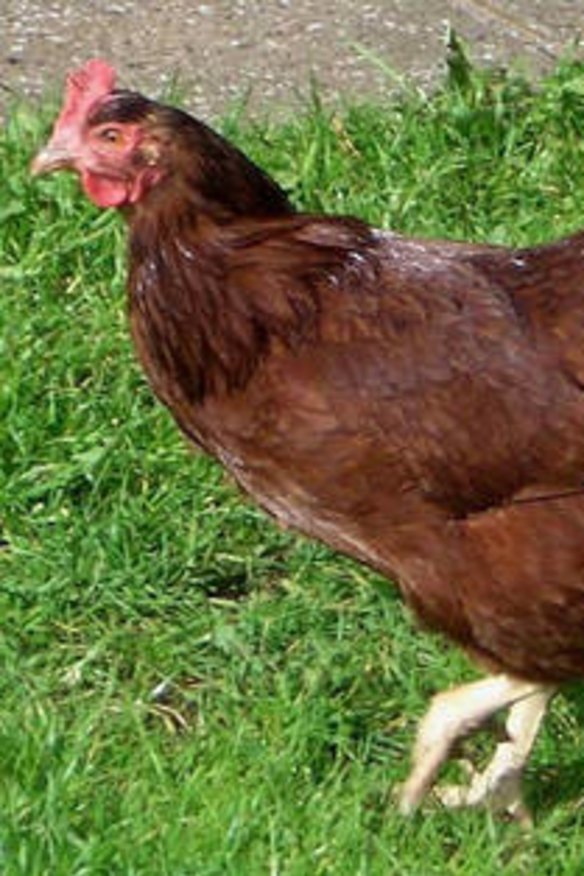What to look for in a backyard chook

We are on a mission - or more correctly, we have been on a mission for 25 years - to find the best breed of chicken for our backyard, and especially for our orchard. Our rural location just north of Hall requires additional criteria as we are more exposed to the weather and we need our hens to be strong as they free range through the fruit trees.
When hens have eaten lots of green grass and milk thistles and greens from the kitchen scraps, their eggs will have brilliant yellow yolks. You'll never want to buy container eggs again.
Our search has taken us far and wide as we have visited many dedicated breeders. In the early days, the children set appearance and size as the most important criteria. We chose bantam-sized hens for ease of handling and also because they would not dig too deeply around the apple trees - their dual purpose being to lay free-range eggs and to eat the grubs (especially colding moth larva overwintering at the base of the apple trees).

Our mission took us to Sydney, the Central Coast, Mudgee, Cowra and Gundagai. Closer to home, we have sourced from Murrumbateman, Wamboin, Sutton, Crookwell and even Uriarra before the bushfires. Our girls when they were little would choose the prettiest looking hens at the Canberra Poultry Show in June each year and then we would go in search of the ones they liked.
Successful breeders who win the big prizes at the Sydney Royal Easter and national poultry shows can command big money, in the hundreds of dollars.
Frizzles with their curling feathers, Chinese Silkies so white in appearance and with such fine feathers, and Pekin bantams with their squat appearance are all beautiful to look at and have a very gentle nature. For us, they proved not so hardy during winter, but they would be fine in a suburban yard with plenty of protection from cold winds.
We have had Light Sussex and Wyandotte bantams, which lay quite large eggs for bantam-sized poultry. The Wyandottes have a spectacular set of colours, including the gold laced, the buff, the silver penciled and the partridge. It has been difficult to find a regular supply of ready-to-lay pullets of these breeds for a reasonable price.
We also have run with black-feather Langshan bantams, which have been hardy and are good layers, but their eggs are quite small.
We have settled on Rhode Island Red and White bantams and Australorp bantams. We also have a small number of full-sized Rhode Island Reds. These breeds are more hardy and can survive windswept winters. They may not be egg-factory birds like Isa Browns, but they have a much longer lifespan and lay eggs through several years. For me, the gentle nature of full-sized Rhode Island Reds is wonderful. They come running to welcome you, clucking all the way as if they want to tell you about their day foraging in the orchard.
Our other challenges have been protecting the hens from predators and sourcing organically grown wheat. Foxes are the bane of any poultry farmer. We house our hens in solid timber hen houses that are closed off at night, and they are surrounded also by an electric fence. They have flexible wiring, so when a fox tries to climb over it, it will be zapped by several wires (you can buy these British-made Electranet fences from Michael Plane of Allsun Farm - you need either a mains or battery-operated electric current pulsator to run it). We have had to add a third barrier, with 50-centimetre steel mesh laid around the hen house to prevent foxes from tunnelling. After rain, they can dig under any free-standing structure and will bite the heads off multiple birds, leaving a scene of carnage. This has been distressing for our children over the years, so when we hear the howl of the foxes coming from One Tree Hill at Hall on a moonlit summer's night, we check that all barriers are in place and fully working.
It is best to keep hens in a protected run that can be moved to fresh grass each couple of days. A structure 1 metre to 1.5 metres in length and width, enclosed with wire mesh and with a shelter box inside, will be heavy enough to not be blown over by wind but light enough to move.
Always supply plenty of water. Ten layers need about three litres of fresh water a day. And feed and shell grit should be available at all times. You can get medium shell grit from stockfeed centres. Hens use it to internally grind up their food and help digestion; it also helps build stronger egg shells.
Hens do not go well when wet. Little chickens are very susceptible to pneumonia. They need to keep their spine warm and dry at all times. That is one good reason for setting eggs under a broody hen as the mother will provide that body heat to the babies as they grow. It may sound gross but it is very beneficial for the baby chickens to be pecking away at the mother's droppings, through which they take in antibodies.
Poultry succumb to a number of pests and diseases. So you need to provide housing that is well ventilated, clean, free from drafts and dampness. If you cannot move the hen house, then frequently rake out the droppings and renew the litter, providing a base of straw. External parasites include the small white lice that live in the feathers. The best and safest treatment is to dust with Pestene on the backside and under the wings. Scaly leg mites can occur on the unfeathered part of the feet and legs; if this occurs, dunk the feet into olive oil to drown the mites and change any wooden roosts, as they live in the timber.
>> Owen Pidgeon runs the Loriendale Organic Orchard near Hall.
This week
■ Beans, zucchinis, cucumbers and lettuces produce crops quite quickly, so if you plant out some rows now, they will produce a harvest around New Year. Build up the garden bed with plenty of compost and broken-down manures.
■ Plant out tomato, capsicum and eggplant seedlings, which you have been raising from seed or seedlings bought from the garden centres. Plant basil alongside your tomatoes in sunny, well-drained parts of the garden, into beds with lots of organic matter and compost. Keep well watered. Cover at night when cool nights are forecast.
■ Prepare planting circles with a raised rim (diameter up to one metre) for planting rockmelon, pumpkins and baby watermelons. Fill the centre of each circle with compost and other well broken-down organic materials then cover with a layer of good garden soil. Plant three seeds or seedlings in each circle and water in well. When transplanting any seedlings, protect them from the sun with an inverted garden pot or bucket for two or three days.
■ Make sure snow peas and climbing beans are attaching themselves to the support frames. Extend if necessary.
■ Plant out coriander and continental parsley seeds directly into the garden bed. Plant a small garden of carrots and keep well watered until germination.
■ Mulch well all new plantings with pea straw, sugar-cane mulch or chopped lucerne hay to keep the soil cool, retain moisture and suppress weeds.
Restaurant reviews, news and the hottest openings served to your inbox.
Sign up